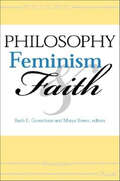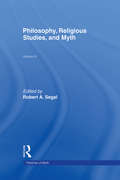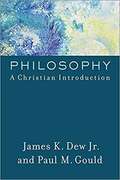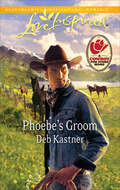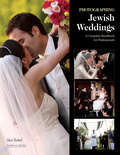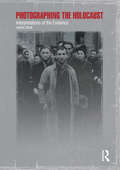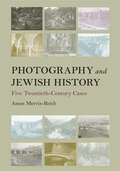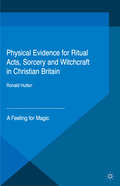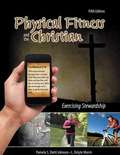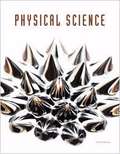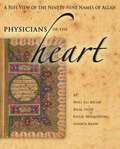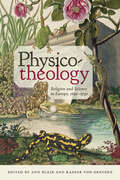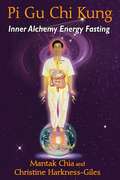- Table View
- List View
Philosophy's Big Questions: Comparing Buddhist and Western Approaches
by Dan Arnold Jan Westerhoff Rick Repetti Amber D. Carpenter Douglas S. Duckworth Stephen J. Laumakis Peter HershockCertain questions have recurred throughout the history of philosophy. They are the big questions—about happiness and the good life, the limits of knowledge, the ultimate structure of reality, the nature of consciousness, the relation between causality and free will, the pervasiveness of suffering, and the conditions for a just and flourishing society—that thinkers in different cultures across the ages have formulated in their own terms in an attempt to make sense of their lives and the world around them.The essays in this book turn to the major figures and texts of the Buddhist tradition in order to expand and enrich our thinking on these enduring questions. Examining them from a comparative and cross-cultural perspective demonstrates the value of alternative ways of addressing philosophical problems, showing how different approaches can produce new and unexpected kinds of questions and answers. Engaging with the Buddhist tradition, this book shows, helps return philosophy to its practical as well as theoretical aim: not only understanding the world but also knowing how to live in it.Featuring striking and generative comparisons of Buddhist and Western thought, Philosophy’s Big Questions challenges our thinking in fundamental ways and offers readers new conceptual tools, methods, and insights for the pursuit of a good and happy life.
Philosophy, Feminism & Faith (Philosophy of Religion)
by Marya Bower Ruth E. Groenhout"The stories are powerful, sometimes heart-rending, sometimes lyrical, but always deeply personal. And there is some very good philosophizing as part of the bargain." —Merold WestphalHow can the seemingly separate lives of philosopher, feminist, and follower of a religious tradition come together in one person's life? How does religious commitment affect philosophy or feminism? How does feminism play out in religious or philosophical commitment? Wrestling with answers to these questions, women who balance philosophy, feminism, and faith write about their lives. The voices gathered here from several different traditions—Catholic, Protestant, Quaker, Jewish, and Muslim—represent diverse ethnicities, races, and ages. The challenging and poignant reflections in Philosophy, Feminism, and Faith show how critical thought can successfully mesh with religious faith and social responsibility.
Philosophy, God and Motion (Routledge Radical Orthodoxy)
by Simon OliverIn the post-Newtonian world motion is assumed to be a simple category which relates to the locomotion of bodies in space, and is usually associated only with physics. This book shows this to be a relatively recent understanding of motion and that prior to the scientific revolution motion was a broader and more mysterious category, applying to moral as well as physical movements. Simon Oliver presents fresh interpretations of key figures in the history of western thought including Plato, Aristotle, Aquinas and Newton, examining the thinkers’ handling of the concept of motion. Through close readings of seminal texts in ancient and medieval cosmology and early modern natural philosophy, the books moves from antique to modern times investigating how motion has been of great significance within theology, philosophy and science. Particularly important is the relation between motion and God, following Aristotle traditional doctrines of God have understood the divine as the ‘unmoved mover’ while post-Holocaust theologians have suggested that in order to be compassionate God must undergo the motion of suffering. The text argues that there may be an authentically theological, as well as a natural scientific understanding of motion. This volume will prove a major contribution to theology, the history of Christian thought and to the growing field of science and religion.
Philosophy, Religious Studies, and Myth: Volume III (Theorists of Myth #Vol. 3)
by Robert A. SegalMuch of the theorizing about myth in philosophy and religious studies grows out of efforts to understand the classics and the Bible. In the case of the classics, the presence of myth has been taken for granted, and conclusions reached about Greek and Roman mythology have spurred generalizations about myth. In the case of the Bible, however, the existence of myth has been contested. In fact, Judaism and Christianity are regularly praised for their nonmythic outlook. Conclusions reached about the presence or absence of myth in either the Hebrew Bible or the New Testament have led to generalizations about myth per se. Many of the essays in this volume apply theories of myth to classical, biblical, and ancient Near Eastern cases, but in so doing they draw conclusions about the nature of myth itself. Those essays that criticize past applications make generalizations as weIl. By no means has aIl theorizing about myth from philosophy and religious studies centered on the ancient world, and this volume contains selections from theories in both disciplines that stern from reflections on the nature of science, language, knowledge, and reality.
Philosophy: A Christian Introduction
by Paul M. Gould James K. Jr DewTwo experienced educators offer an up-to-date introduction to philosophy from a Christian perspective that covers the four major areas of philosophical thought: epistemology, metaphysics, philosophy of religion, and ethics. <p><p> Written from an analytic perspective, the book introduces key concepts and issues within the main areas of philosophical inquiry in a comprehensive yet accessible way, inviting readers on a quest for goodness, truth, and beauty that ultimately points to Jesus as the source of all.
Phoebe Deane (Grace Livingston Hill Series #88)
by Grace Livingston HillBeautiful young Phoebe was desperate! Cruel and cunning Hiram Greene had declared his intention to marry her. At first, Phoebe didn't take Hiram seriously. After all, he couldn't force her into marriage. Then Hiram launched a shrewd campaign of deceit and lies about Phoebe. Soon everyone around her, even her family, seemed determined to make her give in to Hiram. Could she stop what Hiram had started before it was too late? Or would she lose everything--her freedom, her happiness, and her wonderful new friendship with handsome Nathaniel Graham? Grace Livingston Hill is the beloved author of more than 100 books. Read and enjoyed by millions, her wholesome stories contain adventure, romance, and the heart-warming triumphs of people faced with the problems of life and love. There are ninety books by Grace Livingston Hill in the Bookshare collection with the rest on the way.
Phoebe's Groom (Email Order Brides Ser. #1)
by Deb KastnerThe smell of cinnamon buns and apple pie remind widowed dad Chance Hawkins of the wife he lost five years ago. As does his sad-eyed little girl. So when his aunt hires a new pastry chef- whom she finds online-for their family-owned Texas café, the cowboy cook grumbles. What's more, fancy baker Phoebe Yates is boarding in their home. But soon enough, kind Phoebe is reminding Chance how nice it is to share a sweet roll with his daughter before school. And maybe opening his heart to becoming a groom again!
Phoebe: A Story
by Paula GooderSometime around 56 AD, the apostle Paul wrote to the church in Rome. His letter was arguably his theological masterpiece, and has continued to shape Christian faith ever since. He entrusted this letter to Phoebe, the deacon of the church at Cenchreae; in writing to the church that almost surely met in her home, Paul refers to her both as a deacon and as a helper or patron of many. But who was this remarkable woman? In this, her first novel, Biblical scholar and popular author and speaker Paula Gooder tells Phoebe's story - who she was, the life she lived and her first-century faith - and in doing so opens up Paul's theology, giving a sense of the cultural and historical pressures that shaped Paul's thinking, and the faith of the early church. Written in the gripping style of Gerd Theissen's The Shadow of the Galilean, and similarly rigorously researched, this is a novel for everyone and anyone who wants to engage more deeply and imaginatively with Paul's theology - from one of the UK's foremost New Testament scholars.
Phoebe: A Story
by Paula GooderSometime around 56 AD, the apostle Paul wrote to the church in Rome. His letter was arguably his theological masterpiece, and has continued to shape Christian faith ever since. He entrusted this letter to Phoebe, the deacon of the church at Cenchreae; in writing to the church that almost surely met in her home, Paul refers to her both as a deacon and as a helper or patron of many. But who was this remarkable woman? In this, her first work of fiction, Biblical scholar and popular author and speaker Paula Gooder tells Phoebe's story - who she was, the life she lived and her first-century faith - and in doing so opens up Paul's theology, giving a sense of the cultural and historical pressures that shaped Paul's thinking, and the faith of the early church. Written in the gripping style of Gerd Theissen's The Shadow of the Galilean, and similarly rigorously researched, this is a book for everyone and anyone who wants to engage more deeply and imaginatively with Paul's theology - from one of the UK's foremost New Testament scholars. (P) Hodder & Stoughton Ltd
Phoebe: A Story
by Paula GooderSometime around 56 AD, the apostle Paul wrote to the church in Rome. He entrusted this letter to Phoebe, whom he describes as the deacon of the church at Cenchreae and a patron of many. But who was this remarkable woman? Biblical scholar and popular author and speaker Paula Gooder imagines Phoebe's story—who she was, the life she lived, and her first-century faith—and in doing so opens up Paul's world, giving a sense of the cultural and historical pressures that shaped his thinking and the faith of the early church. After the narrative, Gooder includes an extensive notes section with comments on the historical context, biographical details, cultural practices, and more. Rigorously researched, this is a book for anyone who wants to engage more deeply and imaginatively with Paul's theology.
Photographien analysieren: Eine Einführung am Beispiel von Philip-Lorca diCorcias ‚Streetwork‘, einem politischen Selfie und einer Photographie aus Auschwitz (Objektive Hermeneutik in Wissenschaft und Praxis)
by Thomas LoerDer vorliegende Band führt am Beispiel von drei vom Typus, vom Entstehungs- und vom Verwendungszusammenhang her unterschiedlichen Photos aus verschiedenen Forschungszusammenhängen detailliert in die objektiv-hermeneutische Analyse von Photographien ein. Dabei werden auch Konstitutionstheorie und Methodologie so dargestellt, dass die Arbeit mit der Forschungsmethode Objektive Hermeneutik und ihr Erlernen fundiert und fasslich möglich sind. Dem für die Methode zentralen Prinzip der Sachangemessenheit folgt der Band, indem bei der Auswertung der Photographien materiale Fragestellungen bearbeitet werden: (A) die Rekonstruktion neutraler Reziprozität (ähnlich der zivilen Unaufmerksamkeit gemäß Erving Goffman), (B) die Rekonstruktion der politischen Kommunikation via Selfies als eines eigenen Typus der Kommunikation und (C) die Rekonstruktion einer Praxis, von der Georges Didi-Huberman mit Recht sagt, dass sie alle Anthropologie übersteigt. Die Darlegung setzt bei der Planung der Forschung an, behandelt die Fragen der Fallauswahl, der Selektion des Datentypus und der Erhebung, die spezifischen Fragen der Analyse von Photographien und die besondere Form der Ergebnisdarstellung. Eine Liste publizierter objektiv-hermeneutischer Photographieanalysen und ein Glossar zu Begriffen der Objektiven Hermeneutik ergänzen die Darstellung.Mit Exkursen……zu Begriff und Terminus der Interpretation…zur Frage von Sichtbarkeit, Notation und Beschreibung…zum Begriff der strukturellen Reziprozität…zu den Begriffen der Normalität und der Normalisierung…zum Phänomen der Bestattung
Photographing Jewish Weddings: A Complete Handbook for Professionals
by Stan TurkelA guide to the culture and traditions of Judaic ceremonies and receptions, this study offers photographers insight and advice for targeting and capturing Jewish weddings. Time lines and schedules are discussed with examples of start-to-finish wedding-day festivities, and a list of the essential images for the different types of weddings#151;such as Orthodox, Hasidic, Modern, Reform, and Conservative#151;emphasize the key elements photographers are not to miss. A special #147;Marketing 101 for Jewish Weddings” section helps photographers reach these potentially lifelong clients and reveals how these weddings, which sometimes fall on weekdays, can boost sales.
Photographing the Holocaust: Interpretations of the Evidence
by Janina StrukAtrocities committed by the Nazis during the Holocaust were photographed more intensely that any before. In the time since the images were taken they have been subjected to a perplexing variety of treatments: variously ignored, suppressed, distorted and above all exploited for propaganda purposes. With the use of many photographs, including some never before seen, this book traces the history of this process and asks whether the images can be true representations of the events they were depicting. Yet their provenance, Janina Struk argues, has been less important that the uses to which a wide range of political interests has put them, from the desperate attempts of the war-time underground to provide hard evidence of the death camps to the memorial museums of Europe, the US and Israel today.
Photography and Jewish History: Five Twentieth-Century Cases (Jewish Culture and Contexts)
by Amos Morris-ReichIt is a sign of the accepted evidentiary status of photographs that historians regularly append them to their accounts, Amos Morris-Reich observes. Very often, however, these photographs are treated as mere illustrations, simple documentations of the events that transpired. Scholars of photography, on the other hand, tend to prioritize the photographs themselves, relegating the historical contexts to the background. For Morris-Reich, however, photography exists within reality; it partakes in and is very much a component of the history it records. Morris-Reich examines how photography affects categories of history and experience, how it is influenced by them, and the ways in which our understanding of the relationship between history and photography can be theorized and reoriented.Morris-Reich here turns to five twentieth-century cases in which photography and Jewish history intersect: Albert Kahn’s utopian attempt to establish a photographic archive in Paris in order to advance world peace; the spectacular failed project of Helmar Lerski, the most prominent photographer in British Mandate Jewish Palestine; photography in the long career of Eugen Fischer, a Nazi professor of genetics; the street photography of Robert Frank; and the first attempt to introduce photography into the study of Russian Jewry prior to World War I, as seen from the post-Holocaust perspective of the early twenty-first century. Illustrated with nearly 100 images, Photography and Jewish History moves beyond a focus on Jewish photographers or the photographic representation of Jews or Jewish visibility to plumb the deeper and more significant registers of twentieth-century Jewish political history.
Photography as Meditation
by Torsten Andreas HoffmannFor many people, photography serves as a form of meditation; a way to separate themselves from their stressful lives. In this book, Torsten Andreas Hoffmann explores an approach to artistic photography based on Japanese Zen-Philosophy. Meditation and photography have much in common: both are based in the present moment, both require complete focus, and both are most successful when the mind is free from distracting thoughts. Hoffman shows how meditation can lead to the source of inspiration.Hoffman's impressive images of landscapes, cities, people, and nature, as well as his smart image analysis and suggestions about the artistic process, will help you understand this approach to photography without abandoning the principles of design necessary to achieve great images. Photographing busy scenes, especially, requires an inner calm that enables you to have intuition for the right moment and compose a well-balanced image amidst the chaos.The goal of this book is to develop your photographic expression. It provides enrichment for photographers who believe that only technical mastery produces great images and shows how important it is to engage with your own awareness to act creatively.
Physical Evidence for Ritual Acts, Sorcery and Witchcraft in Christian Britain: A Feeling for Magic (Palgrave Historical Studies in Witchcraft and Magic)
by Ronald HuttonThis volume investigates the physical evidence for magic in medieval and modern Britain, including ritual mark, concealed objects, amulets, and magical equipment. The contributors are the current experts in each area of the subject, and show between them how ample the evidence is and how important it is for an understanding of history.
Physical Fitness and the Christian: Exercising Stewardship (Fifth Edition)
by Pamela Diehl Johnson L. Delyte MorrisThe book helps the reader to understand the details of a physical fitness program as a stewardship responsibility and appreciate the life-long personal responsibility involved in pursuing physical fitness.
Physical Science
by R. Terrance Egolf Donald CongdonBeginning with an introduction to why we do science, the Physical Science Student Text, 5th ed., gradually builds the student's understanding of physics concepts in a logical sequence. Beginning with classical mechanics, the text progresses through work and energy, wave phenomena, electricity and magnetism, and light and optics. These transition naturally into the chemistry topics, beginning with the atomic model, then to elements and compounds, chemical reactions, and finishing with solutions, and acids, basis, and salts. Every chapter shows by example why the subject matter is relevant to a Christian worldview of science.
Physical Science Second Edition
by Barbara Ferrier Timothy EimerScience textbook for middle school students
Physical World (student)
by Debbie Lawrence Richard LawrenceStudy introductory physics and the mechanisms of heat, machines, and technology with this accessible course. Machines & Motion: Learn about many fascinating inventions, such as the physical principles behind flight and the advances in communication as you study airplanes, rockets, telephones, computers, and more! Heat & Energy: Discover many kinds of energy that power our lives. From fossil fuels to nuclear power plants, see how God provides our energy needs and learn the wonders of electricity, magnetism, light, and sound. Inventions & Technology: Understand simple machines such as levers and inclined planes. Learn about the law of motion. You will enjoy experimenting with friction, racing rollerskate cars, and making pendulums.
Physicians of the Heart: A Sufi View of the Ninety-Nine Names of Allah
by Wali Ali Meyer Bilal HydeThis book takes the reader into the heart of the mystery of the 99 sacred Names of Allah. It is a vehicle for understanding the infinite nature of God, and for discovering the divine potential in every soul. It is also a comprehensive guidebook for progressing through the stages of the spiritual path and an instruction manual for teachers on how to work with students more wisely, as physicians of the heart. In the process of this voyage to discovery, the reader is systematically exposed to the universal mysticism encoded in the Qur&’an and in the classical Sufi traditions, as well as to a modern psychological approach that works with the 99 Names to achieve individuation and wholeness. This astounding book is a nothing less than a mystical road map into the reality of the Only Being, to the One from whence all the 99 beautiful names of Allah spring, and to which they all point. The collaboration of these scholars and practitioners has yielded a truly profound work of deep spiritual value and psychological insight which should continue to serve the entire community of the "Jerusalem Trilogy" (Jews, Christians, and Muslims) for generations to come. -Rabbi Zalman Schachter-Shalomi, founder of the Jewish Renewal MovementWhat&’s in a name? This book has the answer. Shining light on the semantic, psychological, and spiritual dimensions of the Quranic Names of God, the authors show how the Names are much more than theological abstractions. They are words of power, sovereign remedies for the ailing human heart. -Pir Zia Inayat-Khan, PhD, president of the Sufi Order International and founder of the Suluk Academy and Seven Pillars House of Wisdom The Source of Love promises humanity, &“Call on me in longing and love through intoning My Most Beautiful Names and I will answer your call, far beyond your imagination.&” O seeker, enter the mystical kingdom of the Divine Energies, called the Most Beautiful Names of Allah, by plunging into this remarkable sourcebook, which elucidates the ancient practice of contemplation and chanting of the Names of God, the swiftest path to union. The authors of the book have brought a great gift to the West in their extraordinary and monumental work which elucidates a new field of wisdom in the West. Use this book as a guide on your journey. -Fariha al Jerrahi, -Nur Ashki Jerrahi Sufi Lineage
Physico-theology: Religion and Science in Europe, 1650–1750 (Medicine, Science, and Religion in Historical Context)
by Ann Blair and Kaspar von GreyerzThis first book-length study of physico-theology questions the widespread notion of a steadily advancing early modern separation of religion and science.Beginning around 1650, the emergence of a number of new scientific concepts, methods, and instruments challenged existing syntheses of science and religion. Physico-theology, which embraced the values of personal, empirical observation, was an international movement of the early Enlightenment that focused on the new science to make arguments about divine creation and providence. By reconciling the new science with Christianity across many denominations, physico-theology played a crucial role in diffusing new scientific ideas, assumptions, and interest in the study of nature to a broad public. In this book, sixteen leading scholars contribute a rich array of essays on the terms and scope of the movement, its scientific and religious arguments, and its aesthetic sensibilities.Contributors: Ann Blair, Simona Boscani Leoni, John Hedley Brooke, Nicolas Brucker, Katherine Calloway, Kathleen Crowther, Brendan Dooley, Peter Harrison, Barbara Hunfeld, Eric Jorink, Scott Mandelbrote, Brian W. Ogilvie, Martine Pécharman, Jonathan Sheehan, Anne-Charlott Trepp, Rienk Vermij, Kaspar von Greyerz
Pi Gu Chi Kung: Inner Alchemy Energy Fasting
by Mantak Chia Christine Harkness-GilesA step-by-step guide to the Taoist fasting practice of Pi Gu • Explains how you do not stop eating with this fasting practice and details the simple pi gu diet • Illustrates the chewing and chi kung practices to accompany pi gu, for natural chi energy production • Reveals how Pi Gu Chi Kung activates the body’s natural healing abilities, accelerates the elimination of toxins, reduces appetite and cravings, and enables you to draw energies from the Earth and Universe Pi gu is an ancient Taoist method of fasting for spiritual and healing purposes. Unlike traditional fasting, you do not need to stop eating when practicing pi gu. Used by ancient Taoist masters during their months or years of solitary retreat in pursuit of enlightenment, the practice centers on a simple diet of fruits, teas, nuts, and eggs paired with special chewing techniques and chi kung exercises. During the pi gu state, the need for food decreases yet the body’s energy levels actually increase. The body gathers chi not from food but from chi kung and the “golden elixir” produced by the pi gu chewing practices. The chi produced through pi gu charges your internal organs, activating the body’s natural healing abilities and enabling you to draw energies from the Earth and Universe. In the pi gu state the body automatically balances itself, the mind is more relaxed, and sleep improves. The pause in normal eating makes the body’s cells more sensitive, accelerating the elimination of toxins. The stomach reduces in size, flattening the belly, eliminating cravings, decreasing appetite, and naturally producing weight loss. The body’s meridians stay open, making it easier to attune to meditation, chi kung, and energies from the cosmos. Providing a step-by-step guide to Pi Gu Chi Kung, Master Mantak Chia and coauthor Christine Harkness-Giles explain the pi gu diet, provide immortality tea recipes, detail the pi gu chewing exercises, and illustrate the corresponding chi kung energy exercises. They also explain the use of pi gu during darkness retreats to enhance spiritual awareness and increase mental powers and wisdom.
Pia Desideria
by Theodore G. Tappert Philip Jacob SpenerThis classic work, first published in 1675, inaugurated the movement in Germany called Pietism. In it a young pastor, born and raised during the devastating Thirty Years War, voiced a plea for reform of the church which made the author and his proposals famous. A lifelong friend of the philosopher Leibnitz, Spener was an important influence in the life of the next leader of German Pietism, August Herman Francke. He was also a sponsor at the baptism of Nicholas Zinzendorf, founder of the Moravian Church, whose members played a crucial role in the life of John Wesley.

